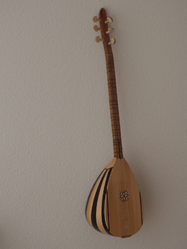Cura (instrument)
The cura (Turkish pronunciation: [dʒuˈɾa]) is a plucked string folk instrument from Turkey. It is the smallest and highest pitched member of the bağlama family of instruments. It is found in nearly every region of the country with varying exact dimensions, tunings, playing techniques, and names including dede sazi, parmak cura, üç telli cura, baglama curasi, and tanbura curasi. The two other members of the bağlama family are the larger tambura and the largest divan sazi, which are one and two octaves lower than the cura, respectively.
 | |
| Classification | |
|---|---|
| Related instruments | |
The instrument has three main parts, the bowl (tekne), the sound board (göğüs), and the neck(sap). The bowl is made from mulberry wood, juniper, beech, spruce, or walnut, the sound board made of spruce, and the neck is made of beech or juniper. The tuning pegs (burgu literally screw). Frets are tied to the neck with fishing line, which allows them to be adjusted. The cura is usually played with a mızrap or tezene, a plectrum made from cherrywood bark or plastic, but in some regions, it is played with the fingers in a style known as Şelpe or Şerpe.
The two-stringed Kozağaç Cura, known as “Two-stringed” in Teke Region, varies in terms of structural and instrumental features.